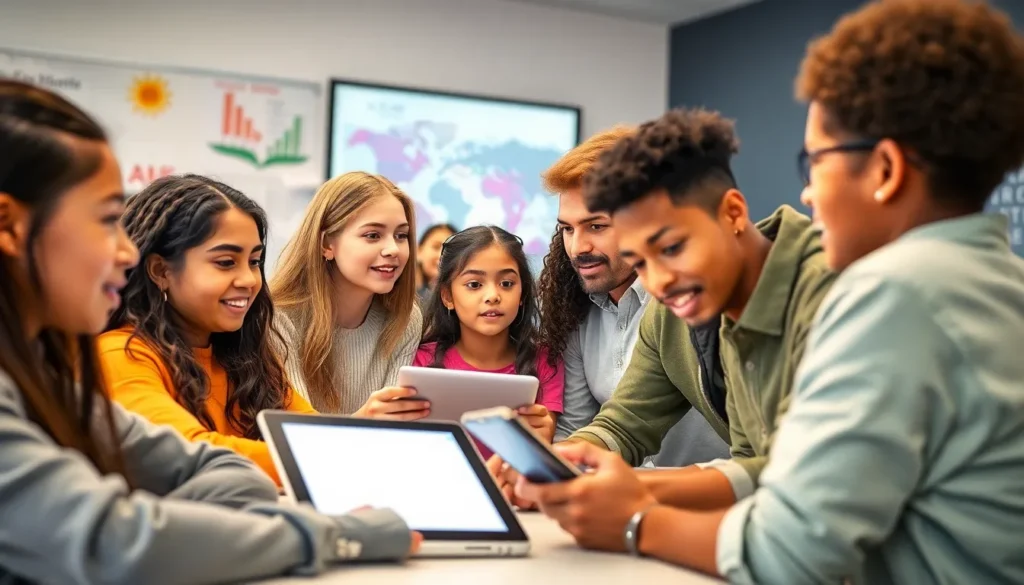Table of Contents
ToggleIn a world where technology evolves faster than a cat meme goes viral, learning technology solutions are the secret sauce for staying ahead. Imagine a classroom where the chalk dust is replaced by interactive screens and where students can learn at their own pace—sounds like a dream, right? Well, it’s not just a fantasy; it’s the reality that innovative tech brings to education.
Overview of Learning Technology Solutions
Learning technology solutions encompass tools and platforms designed to enhance educational experiences. These solutions promote engagement, personalization, and accessibility in the learning process. Tools like Learning Management Systems (LMS) streamline course administration, tracking, and reporting. They simplify the management of educational content, making it easy for instructors to deploy materials.
Interactive technologies, such as smartboards and tablets, facilitate dynamic learning environments. Students can collaborate in real-time, sharing ideas and resources seamlessly. Gamification elements often appear within courses, increasing motivation and participation. Rewards systems encourage learners to engage with content more consistently.
Additionally, mobile learning solutions allow access any time and anywhere. Electronic devices enable learners to interact with course material outside traditional classroom settings. Adaptive learning technologies adjust content delivery based on individual performance, ensuring all students receive the support they require.
Data analytics play a crucial role in assessing learning outcomes. Educators can track student progress and identify areas needing improvement. This data-driven approach targets interventions effectively, making learning more efficient.
Most importantly, these solutions support diverse learning styles. Visual, auditory, and kinesthetic learners all find resources tailored to their preferences. Such inclusivity fosters a positive learning environment where every student can thrive.
Various learning technology solutions exist today, from simple tools to complex platforms. Each solution aims to create an interconnected educational experience, enhancing not just teaching but learning as well. Institutions implementing these technologies report improved student engagement and outcomes.
Types of Learning Technology Solutions

Learning technology solutions encompass various tools that enhance educational experiences. These solutions foster engagement, personalization, and accessibility for students.
E-Learning Platforms
E-learning platforms provide online access to courses and training materials. Examples include Coursera and Udemy, which feature a range of topics suitable for diverse learners. Users benefit from flexibility, having the option to study at their own pace. These platforms often include assessments that help track progress. Additionally, multimedia resources enhance understanding and retention of information.
Learning Management Systems (LMS)
Learning Management Systems (LMS) streamline the administration of educational content. Popular examples consist of Moodle and Canvas, allowing educators to manage course content efficiently. Features include progress tracking, grading systems, and communication tools. Educators can customize learning paths for individual students. Metrics generated by LMS offer insights into student engagement and performance, driving targeted improvements.
Mobile Learning Applications
Mobile learning applications make education accessible anywhere at any time. Examples such as Duolingo and Khan Academy provide interactive content on mobile devices. Users can engage with lessons during their commute or while waiting. Many of these applications include gamification elements that motivate learners. Instant feedback in mobile apps reinforces comprehension and encourages continuous progress.
Benefits of Learning Technology Solutions
Learning technology solutions offer distinct advantages that enhance educational experiences across various settings. These benefits include enhanced accessibility, improved engagement, and streamlined administration.
Enhanced Accessibility
Enhanced accessibility ensures that all students can access educational resources regardless of their physical location. Learning technology solutions provide options like mobile access, enabling users to study anytime and anywhere. Adaptations for those with disabilities, such as screen readers and captioning, further expand inclusivity. Tools like e-learning platforms and applications cater to individual learning paces, allowing every student to thrive. Institutions adopting these solutions often report higher enrollment rates due to increased access.
Improved Engagement
Improved engagement occurs through interactive technologies that spark student interest. Features such as gamification, multimedia content, and collaborative projects keep learners actively involved. Innovative tools, including smartboards and interactive platforms, facilitate dynamic participation in lessons. Data shows that students using these technologies exhibit increased motivation and retention of knowledge. Personalization tools enhance the learning experience by tailoring content to suit individual preferences, making education more relatable.
Streamlined Administration
Streamlined administration simplifies course management for educators. Learning Management Systems (LMS) centralize course materials, making it easy to distribute content and track student progress. Administrative tasks such as grading and scheduling become more efficient through automated processes. Additionally, data analytics provide insights into student performance, enabling targeted interventions. Institutions transitioning to these technologies often experience a reduction in administrative workload, allowing educators to focus more on teaching.
Challenges in Implementing Learning Technology Solutions
Implementing learning technology solutions brings several challenges. Two significant obstacles are technical issues and resistance to change.
Technical Issues
Technical difficulties often arise during the integration of new technologies. Systems may experience compatibility problems with existing infrastructure, leading to disruptions. Educators frequently encounter issues such as poor internet connectivity, which can hinder the seamless use of online tools. Additionally, inadequate training for instructors often results in underutilization of technology resources. Synchronizing updates across multiple platforms may also pose challenges. Institutions must regularly assess their technological readiness to mitigate these issues and ensure smooth operation.
Resistance to Change
Resistance to adopting new technologies can slow progress in educational settings. Some educators may feel comfortable with traditional methods and view new solutions as unnecessary. Concerns about the effectiveness or practicality of technology often stem from unfamiliarity or previous negative experiences. Stakeholders might worry about the investment required for training and resources. Open communication and ongoing support can address these concerns and facilitate a smoother transition. Building a culture that embraces innovation encourages collaboration and fosters enthusiasm for change.
Future Trends in Learning Technology Solutions
Learning technology solutions continue to evolve, incorporating advanced trends that shape educational experiences. Innovations like artificial intelligence and virtual reality play significant roles in this transformation.
Artificial Intelligence and Personalization
Artificial intelligence enhances personalization in learning environments. Intelligent algorithms analyze student data, identifying strengths and weaknesses. They enable tailored content delivery based on individual performance, promoting a customized learning experience. Tools leveraging AI can recommend resources that suit each student’s unique needs, fostering motivation and engagement. Personalization remains crucial, as it addresses diverse learning styles, allowing all students to thrive.
Virtual and Augmented Reality
Virtual and augmented reality revolutionize classroom experiences. Educators use immersive environments to engage students in new ways, facilitating hands-on learning without geographic limitations. Simulated real-world scenarios, such as historical events or complex scientific concepts, become accessible through virtual experiences. Augmented reality overlays digital information, enriching the physical environment and deepening understanding of subjects. These technologies spark curiosity and encourage exploration, profoundly impacting student engagement and retention.
Embracing learning technology solutions is crucial for modern education. These tools not only enhance engagement and accessibility but also streamline administrative tasks for educators. By integrating innovative technologies like AI and VR, institutions can create dynamic learning environments that cater to diverse student needs.
As challenges arise during implementation, fostering a culture of openness and support can ease the transition. The future of education is bright with the potential of these technologies, promising to transform how students learn and interact with content. Adopting these solutions will ultimately lead to improved outcomes and a more inclusive educational landscape.







